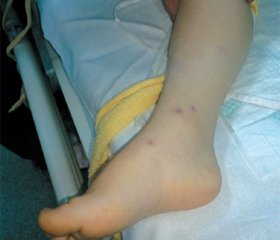Журнал «Здоровье ребенка» Том 17, №8, 2022
Вернуться к номеру
Маски онкологічних захворювань у практиці лікаря-інфекціоніста
Авторы: Крамарьов С.О. (1), Серякова І.Ю. (1), Kolte Roohi (1), Палатна Л.О. (1), Євтушенко В.В. (1), Камінська Т.М. (1, 2), Рязанських А.О. (2)
(1) — Національний медичний університет імені О.О. Богомольця, м. Київ, Україна
(2) —КНП «Київська міська дитяча клінічна інфекційна лікарня», м. Київ, Україна
Рубрики: Педиатрия/Неонатология
Разделы: Справочник специалиста
Версия для печати
Мета даної роботи — на прикладі конкретних випадків нагадати лікарям практичної медицини про важливість диференціальної діагностики з онкологічними захворюваннями в загальній педіатричній практиці й підвищити пильність клініцистів щодо подібності проявів онкопатології та інфекційних хвороб. Ми провели емпіричне описове дослідження 4 клінічних випадків онкологічних захворювань у дітей. Ці випадки ми відібрали серед 21 пацієнта, яким було діагностовано онкологічне захворювання в період проходження стаціонарного лікування в КНП «Київська міська дитяча клінічна інфекційна лікарня» м. Києва впродовж 2014–2019 років. Перший клінічний випадок описує новоутворення головного мозку, що спершу було розцінене як гострий VZV-енцефаліт у дитини 11 років. Другий — це випадок гострого лейкозу в дитини 3 років, яка була госпіталізована з підозрою на менінгококову інфекцію. У третьому випадку ми подали відомості про пацієнта 7 років, який надійшов з інфекційним мононуклеозом і в якого в результаті було діагностовано гемофагоцитарний синдром, імунодефіцитний стан і запідозрено синдром Дункана. Останній випадок демонструє поєднання туберкульозного менінгіту й астроцитоми головного мозку в пацієнта 15 років, що спочатку було прийнято за вірусний енцефаліт. Висновки. Настороженість щодо онкологічних захворювань має важливе значення в діагностиці інфекційних нозологій. Динамічне спостереження й застосування широкого спектра лабораторно-інструментальних засобів дозволяє запобігти діагностичним помилкам і своєчасно розпочати лікування.
The purpose of this work is to remind doctors of practical medicine about the importance of differential diagnosis with cancers in general pediatric practice and to increase the vigilance of clinicians regarding the similarity of manifestations of oncology and infectious diseases on the example of specific clinical cases. We conducted an empirical, descriptive study of 4 clinical cases of cancers in children. We selected them among 21 patients who were diagnosed with cancer during the inpatient treatment at the Kyiv City Children’s Infectious Disease Hospital in 2014–2019. The first clinical case describes a brain neoplasm that was initially thought to be acute VZV encephalitis in an 11-year-old child. The second is a case of acute leukemia in a 3-year-old child who was hospitalized with suspected meningococcal infection. In the third case, we presented a 7-year-old patient who was admitted with infectious mononucleosis and as a result, was diagnosed with hemophagocytic syndrome, immunodeficiency and Duncan disease. The latest case demonstrates the combination of tuberculous meningitis and cerebral astrocytoma in a 15-year-old patient, which was initially mistaken for viral encephalitis. Conclusions. Awareness of cancers is important in the diagnosis of infectious nosologies. Dynamic monitoring and the use of a wide range of laboratory and instrumental methods allows to prevent diagnostic errors and to seek treatment in a timely manner.
онкологічні захворювання; дитячі інфекційні хвороби; злоякісні новоутворення
cancer; childhood infectious diseases; malignant neoplasms
Для ознакомления с полным содержанием статьи необходимо оформить подписку на журнал.
- Araz N.C., Guler E. Delays in Diagnosis of Childhood Cancer in Southeastern Turkey and the Associated Factors. Pediatr. Hematol. Oncol. 2019. 32(2). 153-63.
- Bauchmuller K., Manson J.J., Tattersall R. et al. Haemophagocytic lymphohistiocytosis in adult critical care. J. Intensive Care Soc. 2020. 21(3). 256-268. doi: 10.1177/1751143719893865.
- Чумаченко Н.Г., Марушко Т.Л., Головченко О.В., Фисун В.М., Марушко Р.В. Рецидивний перихондрит як дебютна «маска» гострого лімфобластного лейкозу у дитини раннього віку (клінічний випадок). Сучасна педіатрія. Україна. 2019. 8(104). 8388. doi: 10.15574/SP.2019.104.83.
- Doan T.T., Masom C.P., Mazzaccaro R.J., Kane K.E. Acute Cerebellar Ataxia: An Unusual Pediatric Case. J. Emerg. Med. 2016. 50(5). 769-72.
- Дорош О.І., Трояновська О.О., Абрамюк А.М., Мелько І.П., Цимбалюк І.П., Волошин І.П., Поліщук Р.С. Вторинні пухлини головного мозку у дітей, які отримали променеву та хіміотерапію з приводу гострої лімфобластної лейкемії. Современная педиатрия. 2018. 3(91). 74-85. doi: 10.15574/SP.2018.91.74.
- Dwilow R., Fanella S. Invasive Meningococcal Disease in the 21st Century — An Update for the Clinician. Curr. Neurol. Neurosci Rep. 2015. 15(3). 2.
- Makieieva N.I., Odinets Yu.V., Poddubnaya I.M., Chayka K. Quality of life in children suffering from acute leukemia. Modern Pediatrics. Ukraine. 2020. 3(107). 39–45. doi: 10.15574/SP.2020.107.39.
- Ministry of Health of Ukraine. National cancer control stra–tegy until 2030. 2021. https://moz.gov.ua/article/public-discussions/proekt-postanovi-kabinetu-ministriv-ukraini-pro-zatverdzhennja-nacionalnoi-strategii-kontrolju-onkologichnih-zahvorjuvan-do-2030roku.
- Охотнікова О.M., Поночева O.В. Гемофагоцитарний синдром: гіперзапалення більше, ніж гемофагоцитоз. Що спільного між гемофагоцитарним лімфогістіоцитозом і синдромом активації макрофагів? (Огляд літератури). Клінічна імунологія. Алергологія. Інфектологія. 2018. № 2(107).
- Seo G.H., Kim M.J., Seo S., Hwang B., Lee E., Yun Y. et al. Cancer-specific incidence rates of tuberculosis. Medicine (Baltimore). 2016. 95(38). e4919.
- Steliarova-Foucher E., Colombet M., Ries L.A.G., Moreno F., Dolya A., Bray F. et al. International incidence of childhood cancer, 2001–10: a population-based registry study. Lancet Oncol. 2017. 18(6). 719.
- Tandon P.N. Management of tuberculosis of the central nervous system: Our experience. Natl. Med. J. India. 2018. 31(3). 151-5.
- Thirunavukkarasu S., Santhekadur P.K. Congruities between Cancer and Infectious Diseases: Lessons to be learned from these distinct yet analogous fields. Front. Cell. Infect. Microbiol. Sec. Clinical Microbiology. 2022. doi: 10.3389/fcimb.2022.1072022
- Public Health Center of the Ministry of Health of Ukraine. International day of the child with cancer: what you need to know about cancer in children. 2021. https://www.phc.org.ua/news/mizhnarodniy-den-onkokhvoroi-ditini-scho-treba-znati-pro-rak-u-ditey.
- World Health Organization. 2021. Childhood cancer: https://www.who.int/news-room/fact-sheets/detail/cancer-in-children.
- Yang M., Zhang J.-T., Yao Y., Tan Q.-C., Gao T, Tian C.-L. et al. A Clinical Study of Miliary Brain Tuberculomas in China. Jpn J. Infect. Dis. [Internet]. 2016. 69(3). 231-5.

